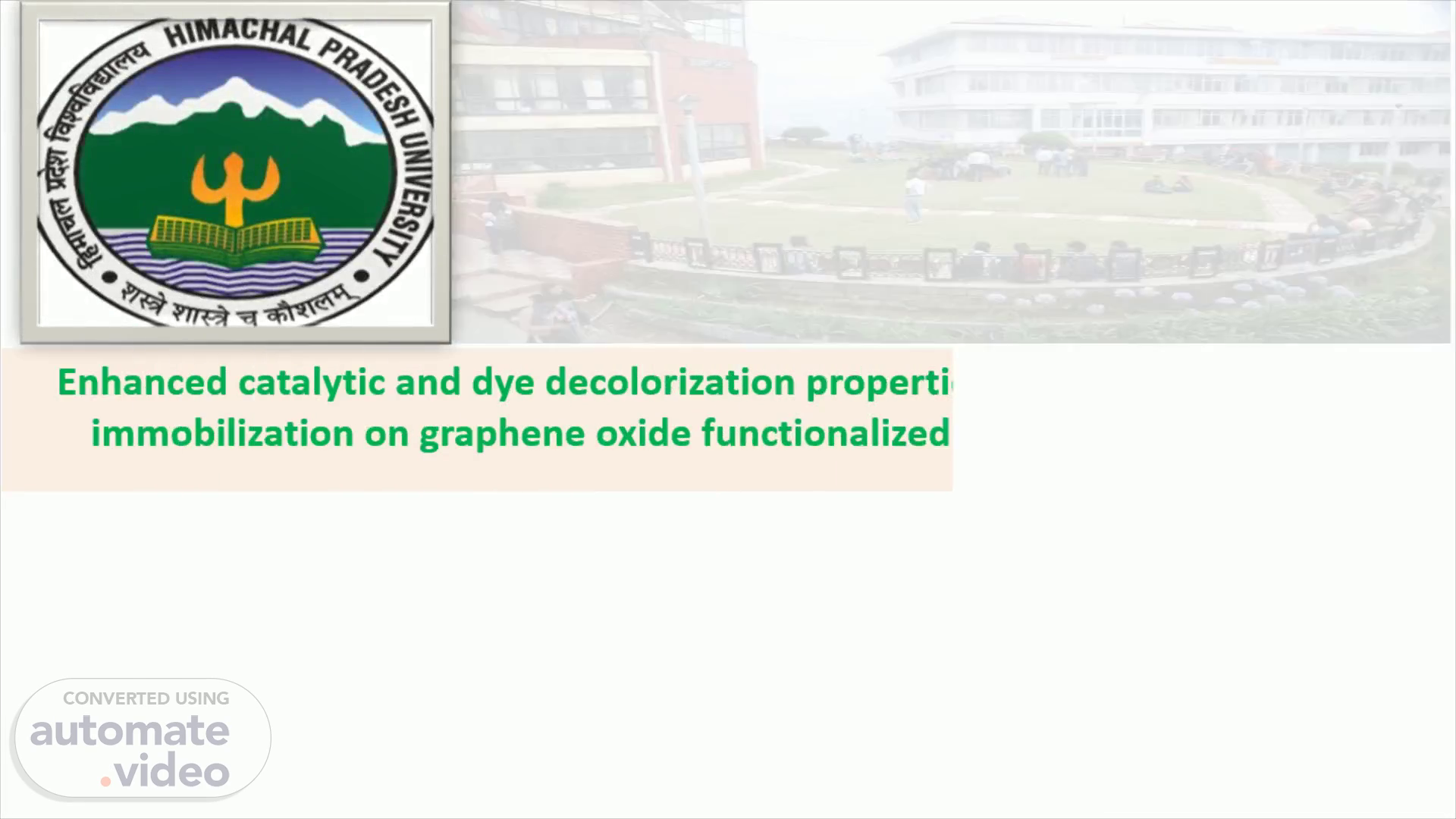
PowerPoint Presentation
Scene 1 (0s)
Enhanced catalytic and dye decolorization properties of Lignin Peroxidase by immobilization on graphene oxide functionalized MnFe 2 O 4 nanoparticles.
Scene 2 (17s)
Outlines. Introduction Experimental Techniques Results Conclusion.
Scene 3 (23s)
[Audio] ENZYMES. Enzymes. Enzymes are three dimension protein molecules of high molecular weight with numerous active sites which accelerate many biochemical reaction in living organism at high rate. It has been used in many industrial activities such as food and pharmaceutical, pulp and paper, wastewater treatment, biosensors, cosmetics, etc..
Scene 4 (1m 17s)
[Audio] Methods of Enzyme Immobilization. As far as industrial applications of enzymes are concerned, it needs to proceed the reactions at harsh environmental conditions. Free enzyme needs to be immobilized by fixing them into a solid insoluble matrix. Immobilized enzymes promote benefits including reduction in production cost by reusability, show outstanding pH and thermal stability under operating conditions, high catalytic efficiency and tolerance to unfavorable conditions. Immobilized enzymes also ensure the purity and quality of final product..
Scene 5 (1m 55s)
[Audio] Matrix used for Immobilization. Matrix used for Immobilization.
Scene 6 (2m 53s)
[Audio] Why. Why MnFe 2 O 4 - Graphene Oxide?. Graphene Oxide : Graphene oxide (GO), one of the important functionalized agent has specific surface are accompanied with numerous reactive contact sites in the form of oxygen functionalities . Properties such as high water solubility, good biocompatibility, porous nature and presence of oxygen functionalilties make it a most suitable nominee for surface modification of magnetic ferrite nanoparticles. Therefore, graphene oxide functionalization on magnetic nanoparticles not only inhibits aggregation and increases stability , but presence of these hydrophilic functional groups on GO surface also leads to the creation of more hydrophilic surface to bind biomolecules ..
Scene 7 (3m 59s)
[Audio] Synthesis of Graphene Oxide. Washing several times with distilled water to get neutral pH Poured 400ml ice H 2 O + Add 3ml of 30% H 2 O 2 Dry at 80 O C Stirring at room temperature Graphite flakes(3 g), H 2 SO 4 (360 ml)+ H 3 PO 4 (40 ml) Add 18g KMnO 4 Stirr at 45 0 C for 12h Brownish Paste Formed Final product Graphene Oxide.
Scene 8 (4m 6s)
[Audio] Synthesis of MFO@rGO composites (in-situ Sol-Gel Autocombustion Method).
Scene 9 (4m 14s)
Synthesis of GO functionalized MFO nanoparticles.
Scene 10 (4m 20s)
XRD Pattern of prepared Samples. XRD Pattern of GO (inset), MFO and MFO@GO nanoparticles.
Scene 11 (4m 36s)
Immobilization of LiP on MFO@GO nanoparticles. .o.a.ocooe. -OOOOOCG Sonication Solvent evaporation, Drying -onococe 80 c Glutaraldehyde Lip immobiliz ation MnFezOa (MFO) Graphene Oxide (GO) o Carbon Hydrogen Nitrogen •eooocc MFO@GO nanoparticles Oxygen Enzyme (Lip).
Scene 12 (5m 4s)
FTIR spectra of MFO, MFO@GO and LiP@MFO@GO nanoparticles.
Scene 13 (5m 27s)
Effect of process parameters on immobilized LiP.
Scene 14 (6m 45s)
Free LiP 1.3427941419140142E-3 1.1611045035459545E-3 1.719989467751075E-3 1.0947592297558303E-3 1.874049874064965E-3 1.1107305035336317E-4 1.5936634095381299E-3 1.3427941419140142E-3 1.1611045035459545E-3 1.719989467751075E-3 1.0947592297558303E-3 1.874049874064965E-3 1.1107305035336317E-4 1.5936634095381299E-3 0.1 5.0000000000000037E-2 3.3333333333333354E-2 2.5000000000000019E-2 2.0000000000000018E-2 1.6666666666666694E-2 1.428571428571429E-2 7.7101002313030104E-2 7.5357950263752832E-2 6.7567567567567571E-2 6.3451776649746314E-2 6.1349693251533874E-2 6.1842918985776124E-2 6.5746219592373492E-2 Immobilized LiP 2.496026501111488E-3 1.4393179451371125E-3 1.1504791541895147E-3 6.3038545109236769E-4 3.5839658772469652E-4 1.4571869026662034E-3 1.8903254036285162E-3 2.496026501111488E-3 1.4393179451371125E-3 1.1504791541895147E-3 6.3038545109236769E-4 3.5839658772469652E-4 1.4571869026662034E-3 1.8903254036285162E-3 0.1 5.0000000000000037E-2 3.3333333333333354E-2 2.5000000000000019E-2 2.0000000000000018E-2 1.6666666666666694E-2 1.428571428571429E-2 8.54700854700855E-2 7.3964497041420316E-2 7.0372976776917728E-2 6.9108500345542556E-2 6.8493150684931503E-2 6.9060773480663029E-2 7.1326676176890216E-2.
Scene 15 (7m 29s)
Temperature dependent enzymatic activity of immobilized LiP.
Scene 16 (8m 0s)
[Audio] Uv-vis absorption specra of free and immobilized LiP for selected dyes.
Scene 17 (8m 42s)
Reusability of immobilized LiP for decolorization of Methylene blue dye..
Scene 18 (9m 16s)
P artially purified Lignin Peroxidase ( LiP ), isolated from Pseudomonas sp, was successfully immobilized on MFO@GO nanoparticles synthesized by sol gel auto combustion method assisted by ultrasonication process. The FTIR analysis clearly revealed the strong and effective connections between enzyme functional groups and nano surface of MFO@GO nanoparticles . Low retentivity and coercivity values in VSM graphs suggested superparamagnetic nature of the synthesized nanoparticles. The immobilized LiP found to have a higher thermal stability, reusability, higher tolerance towards the tested metal ions and solvents in contrast to free one. Immobilized LiP also exhibited great potential for textile dyes degradation with high decolourization efficiency and capability to be recovered from reaction mixture for its reusability up to nine cycles . Therefore, the results obtained in this study may contribute towards affordable biocatalyst by immobilizing them on nano matrices for their efficient recovery to reduce the overall cost of industrial processes that can further be used multiple times without loosing their activity and stability for various industrial and environmental applications..
Scene 19 (9m 44s)
Thanks!. flowers. flowers11. flowers11.